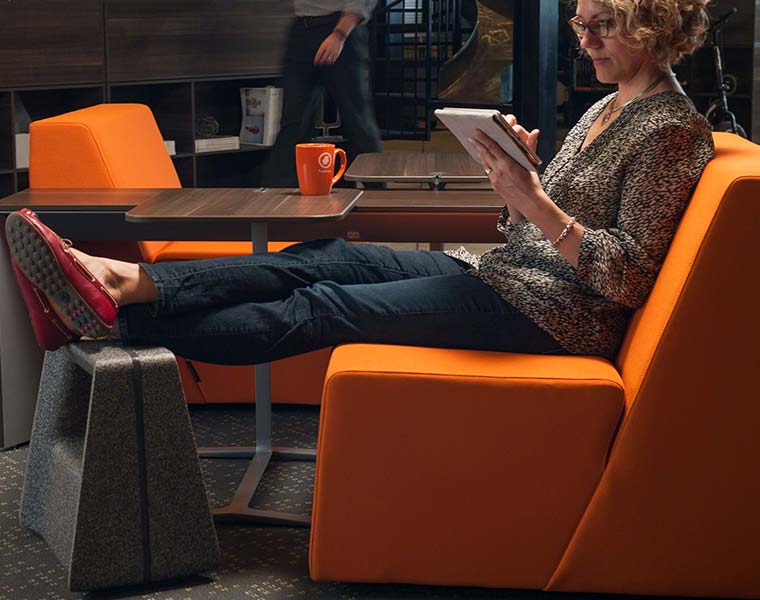The best way to describe what an agile workspace is is by looking at the various elements which come together to create one. This includes everything from concept and rationale through to practical design, furniture and the many benefits.
So, let’s get into it…
Back to basics: an agile workspace definition
Agile working is closely related to the concept of flexible working (although they do have their differences). It’s a breakdown of traditional modes of work to make way for more freedom of movement and professional autonomy.

It addresses where (setting), when and how (devices, postures) staff work to remove pre-existing restrictions through a more human-centric resolution.
The main premise behind the idea of an agile working environment is that it can be quickly and easily adapted as and when necessary.
This means that while staff used to have to work with the resources on offer, they are now more in control of adapting their environment and facilities to their advantage.
For example:

In traditional offices, collaboration or brainstorming typically meant pulling up a number of chairs to gather around one desk or screen. In an office designed for agile working, staff can move away from their desks to a purpose-built collaboration space complete with all of the right technology to make screen-sharing a positive and engaging experience for all participants.
Agile ways of working also offer a multitude of benefits around staff wellbeing, communication and productivity levels which we look at in more detail further down.
The aims of the agile workspace game
- Seeing work as an activity rather than a place to increase staff engagement
- Shifting the focus from adhering to processes to boosting productivity and output
- Encouraging more collaboration, communication and creativity
- Optimising use of office space and eliminating redundant or rarely used areas
- Attraction and retention of talent
- Fostering improved physical and mental health across the workforce
- Acknowledging and facilitating the work-life balance
Let us explain in terms of office fit out, design and furniture…

The ultimate agile workspace layout ideas
Adopting this forward-thinking approach to working life is about more than just implementing an agile working policy.
In order for staff and businesses to reap the rewards of this flexible style of workspace, there needs to be a methodical approach to space planning, office furniture and technology. An agile workplace strategy, if you like.
Here’s our advice:
Open plan office layout – Agile workspaces usually work best in an open plan environment as staff can easily move between work settings without feeling the need to request permission. Open design also allows for touchdown or impromptu work/meetings when transitioning between different spaces.
Collaboration areas – In order to encourage more collaboration, you need to provide the appropriate setting in which to do so.
Modular furniture, communal bench desks and collaborative technology such as media:scape and ClickShare are all collaboration space must-haves.

A place for privacy – In open spaces where staff are regularly moving around and communicating dynamically, it’s paramount to also provide privacy.
This can be done with things like focus pods or acoustic booths which provide seclusion from noise or visual distraction for individual concentration.
Acoustic office solutions are also something we recommend if a client comes to us looking for ways to reduce excess noise in the workplace.
Social spaces – Creating a space where staff can go to relax, rejuvenate or build social bonds with colleagues will improve motivation and communication back ‘at the desk’.
Ergonomic furniture – Whether it’s ergonomically designed task chairs, pull up stools, sit-stand desks or soft seating, provide furniture which caters for specific tasks.
Click for more advice on how to design an agile workspace.
The (many) agile workplace benefits

Cost-saving and value engineering – Eliminating assigned workstations and dedicated desks means the space can be used according to task and requirement rather than by user or professional status.
This lowers overheads, reduces redundant office space and lowers waste of resource.
A boost in productivity and motivation – Accommodating a diverse range of learning and working styles mean you are able to squeeze the most out of your employees’ potential.
Enabling them to work how, where and when they deem best has been proven to boost output and efficiency.

More collaboration and creativity – Providing space and facilities which encourage collaborative activity is a great way to foster more seamless and fluid idea-sharing.
Better physical health and mental wellbeing – Creating a working environment which puts the user first is an effective way to nurture a happier, more satisfied workforce.
Freedom of movement around the office also encourages a healthier level of physical activity throughout the day.
Click for more on the pros and cons of agile working.
